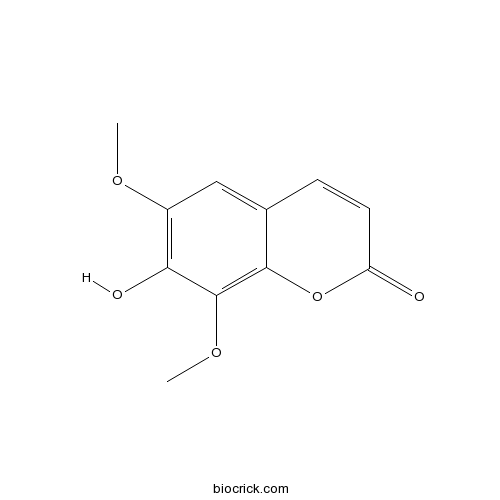Fraxinus mandschurica
Fraxinus mandschurica
1. The products in our compound library are selected from thousands of unique natural products; 2. It has the characteristics of diverse structure, diverse sources and wide coverage of activities; 3. Provide information on the activity of products from major journals, patents and research reports around the world, providing theoretical direction and research basis for further research and screening; 4. Free combination according to the type, source, target and disease of natural product; 5. The compound powder is placed in a covered tube and then discharged into a 10 x 10 cryostat; 6. Transport in ice pack or dry ice pack. Please store it at -20 °C as soon as possible after receiving the product, and use it as soon as possible after opening.
Natural products/compounds from Fraxinus mandschurica
- Cat.No. Product Name CAS Number COA
-
BCN2787
Calceolarioside B105471-98-5
Instructions

-
BCN2327
Isofraxidin486-21-5
Instructions

-
BCN5584
Fraxinol486-28-2
Instructions

Root tip morphology, anatomy, chemistry and potential hydraulic conductivity vary with soil depth in three temperate hardwood species.[Pubmed: 26423336]
Root traits in morphology, chemistry and anatomy are important to root physiological functions, but the differences between shallow and deep roots have rarely been studied in woody plants. Here, we selected three temperate hardwood species, Juglans mandshurica Maxim., Fraxinus mandschurica Rupr. and Phellodendron amurense Rupr., in plantations in northeastern China and measured morphological, anatomical and chemical traits of root tips (i.e., the first-order roots) at surface (0-10 cm) and subsurface (20-30 cm) soil layers. The objectives of this study were to identify how those traits changed with soil depth and to reveal potential functional differences. The results showed that root diameters in deep root tips were greater in J. mandshurica and F. mandschurica, but smaller in P. amurense. However, root stele diameter and the ratio of stele to root diameter in the subsurface layer were consistently greater in all three species, which may enhance their abilities to penetrate into soil. All deep roots exhibited lower tissue nitrogen concentration and respiration rate, which were possibly caused by lower nutrient availability in the subsurface soil layer. Significant differences between shallow and deep roots were observed in xylem structure, with deep roots having thicker stele, wider maximum conduit and greater number of conduits per stele. Compared with shallow roots, the theoretical hydraulic conductivities in deep roots were enhanced by 133% (J. mandshurica), 78% (F. mandschurica) and 217% (P. amurense), respectively, indicating higher efficiency of transportation. Our results suggest that trees' root tip anatomical structure and physiological activity vary substantially with soil environment.
Physiological responses of emerald ash borer larvae to feeding on different ash species reveal putative resistance mechanisms and insect counter-adaptations.[Pubmed: 25956198]
Emerald ash borer, Agrilus planipennis Fairmaire, an Asian wood-boring beetle, has devastated ash (Fraxinus spp.) trees in North American forests and landscapes since its discovery there in 2002. In this study, we collected living larvae from EAB-resistant Manchurian ash (Fraxinus mandschurica), and susceptible white (Fraxinus americana) and green (Fraxinus pennsylvanica) ash hosts, and quantified the activity and production of selected detoxification, digestive, and antioxidant enzymes. We hypothesized that differences in larval physiology could be used to infer resistance mechanisms of ash. We found no differences in cytochrome P450, glutathione-S-transferase, carboxylesterase, sulfotransferase, and tryptic BApNAase activities between larvae feeding on different hosts. Despite this, Manchurian ash-fed larvae produced a single isozyme of low electrophoretic mobility that was not produced in white or green ash-fed larvae. Additionally, larvae feeding on white and green ash produced two serine protease isozymes of high electrophoretic mobility that were not observed in Manchurian ash-fed larvae. We also found lower activity of β-glucosidase and higher activities of monoamine oxidase, ortho-quinone reductase, catalase, superoxide dismutase, and glutathione reductase in Manchurian ash-fed larvae compared to larvae that had fed on susceptible ash. A single isozyme was detected for both catalase and superoxide dismutase in all larval groups. The activities of the quinone-protective and antioxidant enzymes are consistent with the resistance phenotype of the host species, with the highest activities measured in larvae feeding on resistant Manchurian ash. We conclude that larvae feeding on Manchurian ash could be under quinone and oxidative stress, suggesting these may be potential mechanisms of resistance of Manchurian ash to EAB larvae, and that quinone-protective and antioxidant enzymes are important counter-adaptations of larvae for dealing with these resistance mechanisms.
Comparison of the pyrolysis behavior of lignins from different tree species.[Pubmed: 19393737]
Despite the increasing importance of biomass pyrolysis, little is known about the pyrolysis behavior of lignin--one of the main components of biomass--due to its structural complexity and the difficulty in its isolation. In the present study, we extracted lignins from Manchurian ash (Fraxinus mandschurica) and Mongolian Scots pine (Pinus sylvestris var. mongolica) using the Bjorkman procedure, which has little effect on the structure of lignin. Fourier transform infrared (FTIR) spectrometry was used to characterize the microstructure of the Bjorkman lignins, i.e., milled wood lignins (MWLs), from the different tree species. The pyrolysis characteristics of MWLs were investigated using a thermogravimetric analyzer, and the release of the main volatile and gaseous products of pyrolysis were detected by FTIR spectroscopy. During the pyrolysis process, MWLs underwent thermo-degradation over a wide temperature range. Manchurian ash MWL showed a much higher thermal degradation rate than Mongolian Scots pine MWL in the temperature range from 290-430 degrees C. High residue yields were achieved at 37 wt.% for Mongolian Scots pine MWL and 26 wt.% for Manchurian ash MWL. In order to further investigate the mechanisms of lignin pyrolysis, we also analyzed the FTIR profiles for the main pyrolysis products (CO(2), CO, methane, methanol, phenols and formaldehyde) and investigated the variation in pyrolysis products between the different MWLs.


